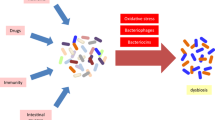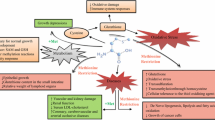Abstract
The amount of iron in the body is controlled at the point of absorption in the proximal small intestine. Dietary iron enters the intestinal epithelium via the brush-border transporter DMT1 and exits through the basolateral membranes. The basolateral transfer of iron requires two components: a copper-containing iron oxidase known as hephaestin and a membrane transport protein IREG1. The amount of iron traversing the enterocytes is directly related to body iron requirements and inversely related to the iron content of the intestinal epithelium. We propose that body signals control iron absorption by first acting on crypt enterocytes to determine the expression of basolateral transport components. This, in turn, modulates the intracellular iron content of mature epithelial cells, which ultimately determines the activity of the brush-border transporter DMT1.
Similar content being viewed by others
References
Bothwell, T. H., Charlton, R. W., Cook, J. D., and Finch, C. A. (1979) Iron Metabolism in Man, Blackwell Scientific, Oxford.
Raja, K. B., Simpson, R. J., and Peters, T. J. (1992) Investigation of a role for reduction in ferric iron uptake by mouse duodenum. Biochim. Biophys. Acta 1135, 141–146.
McKie, A. T., Barrow, D., Latunde-Dada, G. O., Rolfs, A., Sagar, G., Mudaly, E., et al. (1999) An iron-regulated ferric reductase associated with the absorption of dietary iron Science 291, 1755–1759.
Gunshin, H., Mackenzie, B., Berger, U. V., Gunshin, Y., Romero, M. F., Boron, W. F., et al. (1997) Cloning and characterization of a mammalian proton-coupled metal-ion transporter. Nature 388, 482–488.
Fleming, M. D., Trenor, C. C., Su, M. A., Foernzler, D., Beier, D. R., Dietrich, W. F., et al. (1997) Microcytic anaemia mice have a mutation in Nramp2, a candidate iron transport gene. Nature Genet. 16, 383–386.
Vulpe, C. D., Kuo, Y.-M., Murphy, T. L., Cowley, L., Askwith, C., Libina, N., et al. (1999) Hephaestin: a ceruloplasmin homologue implicated in intestinal iron transport and its defect in the sla mouse. Nature Genet. 21, 195–199.
McKie, A. T., Marciani, P., Rolfs, A., Brennan, K., Wehr, K., Barrow, D., et al. (2000) A novel duodenal iron-regulated transporter, IREG1, implicated in the basolateral transfer of iron to the circulation. Mol. Cell. 5, 299–309.
Donovan, A., Brownlie, A., Zhou, Y., Shepard, J., Pratt, S. J., Moynihan, J., et al. (2000) Positional cloning of zebrafish ferroportin 1 identifies a conserved vertebrate iron exporter. Nature 403, 776–781.
Abboud, S. and Haile, D. J. (2000) A novel mammalian iron-regulated protein involved in intracellular iron metabolism. J. Biol. Chem. 275, 19—906—19,912.
Russell, E. S. (1979) Hereditary anemias of the mouse: a review for geneticists. Adv. Genet. 20, 357–459.
Anderson, G. J., Murphy, T. L., Cowley, L., Evans, B. A., Halliday, J. W., and McLaren, G. D. (1998) Mapping the gene for sex-linked anemia: an inherited defect of intestinl iron absorption in the mouse. Genomics 48, 34–39.
Frazer, D. M., Vulpe, C. D., McKie, A. T., Wilkins, S. J., Trinder, D., Cleghorn, G. J., et al. (2001) Cloning and gastrointestinal expression of rat hephaestin: relationship to other iron transport proteins. Am. J. Physiol. Gastrointest. Liver Physiol. 281, G931-G939.
Meyer, L. A., Durley, A. P., Prohaska, J. R., and Harris, Z. L. (2001) Copper transport and metabolism are normal in aceruloplasminemic mice. J. Biol. Chem. 276, 36,857–36,861.
Gitlin, J. D. (1998) Aceruloplasminemia. Pediatr. Res. 44, 271–276.
Harris, Z. L., Durley, A. P., Man, T. K., and Gitlin, J. D. (1999) Targeted gene disruption reveals an essential role for ceruloplasmin in cellular iron efflux. Proc. Natl. Acad. Sci. USA 96, 10,812–10,817.
Lee, G. R., Nacht, S., Lukens, J. N., and Cartwright, G. E. (1968) Iron metabolism in copper-deficient swine. J. Clin. Invest. 47, 2058–2069.
Attieh, Z., Alaeddine, R. M., Su, T., Anderson, G., and Vulpe, C. (2001) Identification of a feroxidase activity for hephaestin. Proceedings of Bioiron 2001. World Congress on Iron Metabolism, Cairns, Australia 184.
Askwith, C. C., de Silva, D., and Kaplan, J. (1996) Molecular biology of iron acquisition in Saccharomyces cerevisiae. Mol. Microbiol. 20, 27–34.
Njajou, O. T., Vaessen, N., Joosse, M., Berghuis, B., van Dongen, J. W., Breuning, M. H., et al. (2001) A mutation in SLC11A3 is associated with autosomal dominant hemochromatosis. Nature Genet. 28, 213–214.
Montosi, G., Donovan, A., Totaro, A., Garuti, C. Pignatti, E., Cassanelli, S., et al. (2001) Autosomal-dominant hemochromatosis is associated with a mutation in the ferroportin (SLC11A3) gene. J. Clin. Invest. 108, 619–623.
Feder, J. N., Gnirke, A., Thomas, W., Tsuchihashi, Z., Ruddy, D. A., Basava, A. et al. (1996) A novel MHC class I-like gene is mutated in patients with hereditary haemochromatosis. Nature Genet. 13, 399–408.
Mendel, G. A. (1961) Studies of iron absorption. I. The relationships between the rate of erythropoiesis, hypoxia and iron absorption. Blood 18, 727–736.
Conrad, M. E. and Crosby, W. H. (1963) Intestinal mucosal mechanisms controlling iron absorption. Blood 22, 406–415.
Richmond, V. S., Worwood, M., and Jacobs, A. (1972) The iron content of intestinal epithelial cells and its subcellular distribution: studies on normal, iron-overloaded and iron-deficient rats. Br. J. Haematol. 23, 605–614.
Lombard, M., Bomford, A. B., Polson, R. J., Bellingham, A. J., and Williams, R. (1990) Differential expression of transferrin receptor in duodenal mucosa in iron overload. Evidence for a site-specific defect in genetic hemochromatosis. Gastroenterology 98, 976–984.
Wheby, M. S., Jones, L. G., and Crosby, W. H. (1964) Studies on iron absorption. Intestinal regulatory mechanisms. J. Clin. Invest. 43, 1433–1442.
Marx, J. J. (1979) Mucosal uptake, mucosal transfer and retention of iron, measured by whole-body counting. Scand. J. Haematol. 23, 293–302.
McLaren, G. D., Nathanson, M. H., Jacobs, A., Trevett, D., and Thomson, W. (1991) Regulation of intestinal iron absorption and mucosal iron kinetics in hereditary hemochromatosis. J. Lab. Clin. Med. 117, 390–401.
Trinder, D., Oates, P. S., Thomas, C., Sadleir, J., and Morgan, E. H. (2000) Localisation of divalent metal transporter 1 (DMT1) to the microvillus membrane of rat duodenal enterocytes in iron deficiency, but to hepatocytes in iron overload. Gut 46, 270–276.
Canonne-Hergaux, F., Gruenheid, S., Ponka, P., and Gros, P. (1999) Cellular and subcellular localization of the Nramp2 iron transporter in the intestinal brush border and regulation by dietary iron. Blood 93, 4406–4417.
Powell, L. W., Campbell, C. B., and Wilson, E. (1970) Intestinal mucosal uptake of iron and iron retention in idiopathic haemochromatosis as evidence for a mucosal abnormality. Gut 11, 727–731.
Raja, K. B., Simpson, R. J., Pippard, M. J., and Peters, T. J. (1998) In vivo studies on the relationship between intestinal iron (Fe3+) absorption, hypoxia and erythropoiesis in the mouse. Br. J. Haematol. 68, 373–378.
Schumann, K., Moret, R., Kunzle, H., and Kuhn, L. C. (1999) Iron regulatory protein as an endogenous sensor of iron in rat intestinal mucosa. Possible implications for the regulation of iron absorption. Eur. J. Biochem. 260, 362–372.
Yeh, K. Y., Yeh, M., Watkins, J. A., Rodriguez-Paris, J., and Glass, J. (2000) Dietary iron induces rapid changes in rat intestinal divalent metal transporter expression. Am. J. Physiol. 279, G1070-G1079.
Zoller, H. Pietrangelo, A., Vogel, W., and Weiss, G. (1999) Duodenal metal-transporter (DMT-1, NRAMP-2) expression in patients with hereditary haemochromatosis. Lancet 353 2120–2123.
Author information
Authors and Affiliations
Corresponding author
Rights and permissions
About this article
Cite this article
Anderson, G.J., Frazer, D.M., McKie, A.T. et al. The expression and regulation of the iron transport molecules hephaestin and IREG1. Cell Biochem Biophys 36, 137–146 (2002). https://doi.org/10.1385/CBB:36:2-3:137
Issue Date:
DOI: https://doi.org/10.1385/CBB:36:2-3:137




